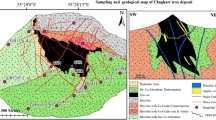Abstract
The formation of the Mufushan granopegmatite was closely related to the Late Yenshanian multiphase and multistage magmatic activities. More than one generation of beryl and aquamarine occur in different types of pegmatite in the granites. The presence of melt and melt-fluid inclusions strongly indicates a melt-solution character of the pegmatitic magma. Forming temperatures of the different generations of beryl in a Na+-K+-Ca2+-CO3 2−-Cl−-SO4 2− solution ranges from 990 °C to 200 °C Aquamarine was formed at 720–180 °C. The contents of alkali metals (Na+ + K+) in the ore-formming solution of aquamarine are lower than those in the beryl, but the contents of alkali earths (Ca) and salinity are higher. The granite was generated by remelting of the basement formation (meta-sedimentary rocks of the Lengjiaxi Group) which also served as the source of ore-forming material. Beryllium in the pegmatite was transported mainly in the form of Na2[Be(CO3)2], with part of it being complexed with Cl− and SO4 2−. During the generation and evolution of the pegmatite, equilibrium might have been reached in the solid-melt-fluid or solid-fluid system. The intergranular solutions may have reacted with the early crystallized minerals, resulting in potash-feldsparization, albitization and muscovitization during which the ore-forming elements were mobilized and transported in favour of ore deposition.
Similar content being viewed by others
References
Bius, A. A., 1960. Geochemistry of beryl and genetic types of beryl ore deposits: Acad. Sci., USSR Press (in Russian).
Bulaks, A. G., 1974, Method of thermodynamics and mineralogy: Nedra Press, Leningrad, p. 184–190 (in Russian).
Chen Yinhan, 1991. Ruby, sapphire and their inclusions, China: Acta Mineralogica Sinica, v. 11, p. 298–304 (in Chinese).
Li Zhaolin, 1986, Intergranular solution and its implications in oregenesis: Acta Geologica Sinica, v. 5, p. 189–200 (in Chinese).
Li Zhaolin (editor in chief), 1988, Experimental Geochemistry: Beijing, Geological Press, p. 227–312 (in Chinese).
Liu Yingjun et al., 1984, Geochemistry of Elements: Beijing, Science Press, p. 146–148 (in Chinese).
Lu Huanzhang, 1990. Fluid-melt inclusions: Geochimica, n.3, p.225–229 (in Chinese).
Peng Mingsheng, 1985, Spectrographic characteristics of Altay aquamarine, Xinjiang: Acta Mineralogica Sinica, v. 5, p. 140–145 (in Chinese).
Zhen Ruifan, 1987, Aquamarine in Northeast Hunan: Acta Mineralogica Sinica, v. 7, p. 92–93 (in Chinese).
Zhou Tianren, 1975. Genesis and classification of granopegmatite: Geochemistry, n.3. p.167–171.
Author information
Authors and Affiliations
Additional information
This project was jointly funded by the National Natural Science Foundation of China and the Open Laboratory of Ore Deposit Geochemistry, Academia Sinica.
Rights and permissions
About this article
Cite this article
Zhaolin, L., Yanhua, M., Lihong, L. et al. Physicochemical conditions of the formation of beryl and aquamarine in Mufushan granopegmatite deposit, Hunan Province, China. Chin. J. of Geochem. 13, 326–339 (1994). https://doi.org/10.1007/BF02838522
Issue Date:
DOI: https://doi.org/10.1007/BF02838522




